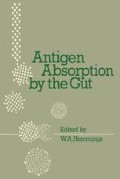Abstract
My role today will be to review the clinical significance of endotoxin absorption from the gut and to expose the problem, to which we do not yet know the answer … how is endotoxin able to cross the gut mucosa? The endotoxins of Gram negative bacteria all have a similar structure. At one end of the tripartite molecule is an O-specific polysaccharide which is made up of repeating oligosaccharide units, in the middle is the common core polysaccharide and the really toxic end of the molecule is known as lipid A. This lipid A includes the fatty acids, lauric, myristic and palmitic acids attached to hydroxyl and amino groups on glucosamine. The lipid A is the part which attaches the molecule to the phospholipid of cell membranes. The overall action of endotoxin can be one of total destruction and in this respect the analogy of structure to a nuclear warhead is quite appropriate. The molecular weight is one million but it can be broken into units of 400 000 daltons size which still show biological activity.
Access this chapter
Tax calculation will be finalised at checkout
Purchases are for personal use only
Preview
Unable to display preview. Download preview PDF.
References
Fine, J. (1956). Effect of peripheral vascular collapse on the antibacterial defense mechanisms. Ann. N.Y. Acad. Sci., 66, 329
Fréter, R. (1974). Interactions between mechanisms controlling the intestinal flora. Am. J. Clin. Nutr., 27, 1409
Gans, H. (1974). Effect of ligation of the heptic artery or occlusion of the portal vein on the development of endotoxinaemia. Surg. Gynecol. Obstet., 139, 689
Kenny, J.F., Weinert, D. W. and Gray, J. A. (1974). Failure of specific immunity to alter intestinal colonization of infants and adults. J. Infect. Dis., 129, 10
Olcay, I., Kitahama, A., Miller, R. H., Drapanas, T., Trejo, R. A. and DiLuzio, N. R. (1974). Reticuloendothelial dysfunction and endotoxinaemia following portal vein occlusion. Surgery, 75, 64
Ravin, H. A., Rowley, D., Jenkins, C. F. and Fine, J. (1960). On the absorption of bacterial endotoxin from the gastrointestinal tract of the normal and shocked animal. Journal of Experimental Medicine, 112, 783
Reinhold, R. B. and Fine, J. (1971). A technique for quantitative measurement of endotoxin in human plasma. Proc. Soc. Exp. Biol. Med., 137, 334
Shreeve, B. J. and Thomlinson, J. R. (1972). Absorption of E. coli endotoxin by the neonatal pig. J. Md. Microbiol., 5, 55
Skarnes, R. C. (1970). Host defence against bacterial endotoxinaemia. J. Exp. Med., 132, 300
Watson, D. W. (1971). Gram negative sepsis. Beechams Pharmaceuticals Symposium. Publisher R. E. Fuiz. Clifton, N. J. 07012. Ed. J. P. Sandford. p.40–46
Wardle, E. N. (1974). Fibrinogen catabolism and endotoxinaemia in liver disease. Arch. Surg. 109, 741
Wardle, E. N. (1975a). Endotoxin and acute renal failure. Nephron, 14, 321
Wardle, E. N. (1975b). Endotoxinaemia and the pathogenesis of acute renal failure. Q. J. Med., 44, 389
Witznitzer, T., Schweinburg, F. B., Atkin, N. and Fine, J. (1960). On the relation of the size of the intra-intestinal pool of endotoxin to the development of irreversibility in hemorrhagic shock. J. Exp. Med., 112, 1167
Woodruff, P. W. H., Carroll, D., Koizumi, S. and Fine, J. (1973). Role of the intestinal flora in major trauma. J. Infect. Dis., Suppl. 128, s.290
Editor information
Editors and Affiliations
Rights and permissions
Copyright information
© 1978 MTP Press Limited
About this chapter
Cite this chapter
Wardle, E.N. (1978). A review of endotoxin and its absorption from the gut. In: Hemmings, W.A. (eds) Antigen Absorption by the Gut. Springer, Dordrecht. https://doi.org/10.1007/978-94-011-6609-6_18
Download citation
DOI: https://doi.org/10.1007/978-94-011-6609-6_18
Publisher Name: Springer, Dordrecht
Print ISBN: 978-94-011-6611-9
Online ISBN: 978-94-011-6609-6
eBook Packages: Springer Book Archive

